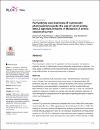Perceptions and practices of community pharmacists towards the use of short-acting beta-2 agonists inhalers in Malaysia: A cross-sectional survey
| Author | Loh, Zhe Chi |
| Author | Hussain, Rabia |
| Author | Ababneh, Bayan Faisal |
| Author | Muneswarao, Jaya |
| Author | Ong, Siew Chin |
| Author | ur-Rehman, Anees |
| Author | Babar, Zaheer Ud Din |
| Available date | 2025-10-14T11:07:31Z |
| Publication Date | 2025-06-11 |
| Publication Name | Plos One |
| Identifier | http://dx.doi.org/10.1371/journal.pone.0324982 |
| Citation | Loh, Z. C., Hussain, R., Ababneh, B. F., Muneswarao, J., Ong, S. C., Ur-Rehman, A., & Babar, Z. U. D. (2025). Perceptions and practices of community pharmacists towards the use of short-acting beta-2 agonists inhalers in Malaysia: A cross-sectional survey. PLoS One, 20(6), e0324982. |
| ISSN | 1932-6203 |
| Abstract | Background There has been a relative lack of exploration into the perceptions and practices regarding the use of SABA inhalers among healthcare professionals in Malaysia. The study aimed to determine community pharmacists’ perceptions and practices towards using SABA inhalers at community pharmacies in Malaysia. Methods It was a cross-sectional study conducted using a self-administered, web-based survey (Google Form) among community pharmacists in Malaysia between 26<sup>th</sup> December 2022 and 25<sup>th</sup> May 2023. Descriptive statistics were used to summarize the participants’ socio-demographic characteristics, and the Kruskal-Wallis and Mann-Whitney U tests were applied to continuous data and p < 0.05 was considered significant. Regression analysis was carried out to identify associated predictors of socio-demographic characteristics of the participants regarding perception of asthma control and management. Results A total of 312 community pharmacists completed the survey. Most of the participants were females (64.1%, n = 200), aged between 29 and 38 years (51.0%, n = 159). The majority of community pharmacists agreed that achieving good asthma control led to minimal asthma symptoms (n = 263, 84.3%) and fewer requirements for medical interventions (n = 204, 65.4%). Additionally, most participants were engaged in educating their patients about the correct techniques for using asthma inhalers (93.6%, n = 292) and provided sufficient information about the safe use of SABA inhalers (79.5%, n = 248). The most frequently perceived facilitator (n = 235, 75.4%) was providing additional follow-up sessions, and the primary perceived barrier (n = 232, 74.4%) was the lack of patients’ awareness of the provided asthma care services. Conclusion Community pharmacists acknowledged that good asthma control was associated with minimal medical assistance and symptoms. However, some concerns were expressed over asthma patients’ purchase of non-prescription SABA inhalers. The participants perceived some barriers, such as lack of patient awareness regarding the asthma care services availability that might hinder the safe use of SABA inhalers. |
| Language | en |
| Publisher | Public Library of Science (PLOS) |
| Subject | beta-2 Malaysia |
| Type | Article |
| Issue Number | 6 June |
| Volume Number | 20 |
Files in this item
This item appears in the following Collection(s)
-
Pharmacy Research [1447 items ]


